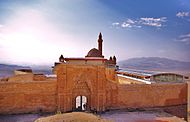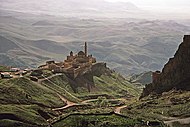Ishak Pasha Palace


Ishak Pasha Palace (Turkish: İshak Paşa Sarayı) is a semi-ruined palace and administrative complex located in the Doğubeyazıt district of Ağrı province of eastern Turkey.
Ishak Pasha Palace is a palace whose construction was started by Kurdish chiefs from the Besyan tribe of Beyazıd Sanjak and its construction was completed in 1784 by the Kurdish sanjak chief Ishak Pasha. The administration of Bayezid Sanjak was passed from father to son. Turkish writer Katip Çelebi also says the same thing on this subject and he is talking about Behlul Bey, the Kurdish chief of the sanjak in 1635. İshak Pasha from Childir Eyalet had never been in Bayezid during his life. Two people are confused. These two people are different people with the same name.[1]
The Ishak Pasha Palace is one of the few examples of surviving historical Ottoman palaces.[2]
The palace was depicted on the reverse of the Turkish 100 new lira banknote of 2005–2009.[3]
History[]
Building of the palace commenced in 1685 and continued for decades. The work was finished in 1784 or 1785 CE. The palace was damaged by an earthquake in 1840 and for some time abandoned, but partly restored over the next 20 years. It was again damaged during the Russo-Turkish War (1877-1878). The structure was later used by Russians and during World War I when it was damaged by gunfire.[4]
Later, the palace was used as the administrative centre for the area, and later as a military fort until 1937. Additional damage was caused later when stone from the building was taken for use to build new homes.[5]
In 2000, the palace was added to the UNESCO Tentative List of World Heritage Sites. The UNESCO summary states:[6]
Palace on the Silk Route near the Iranian frontier ... It is not at all in the Ottoman tradition but is rather a mixture of Anatolian, Iranian and North Mesopotamian architectural tradition. The traditional model used in the construction of the Royal Palaces in the capital cities like Bursa, Edirne and Istanbul was taken as an example in the design of Ishak Pasha Palace. The western influence in Ottoman architecture during the post-classical period can be observed...
Major structural problems were found during a 2004 restoration and not fully repaired. In During a subsequent restoration, a new roof was added, as well as a shelter over some parts of the palace, made of wood and glass.[7] Naturally, this changed the historic character of the palace.[8] Another restoration started in 2011.
Visits are possible for a fee; visitors can view the Urartian rock tombs discovered in 1830 and said to be from centuries ago, perhaps between the 13th and the 9th century BCE.[9][2]
Sections of the palace[]



The complex consists of following sections:[10]
- Exterior façades
- First and second courts
- The men's quarter (selamlık)
- The mosque
- The soup kitchen (Darüzziyafe)
- Bath
- Harem Section
- Hall for ceremonies and entertainment
- Arch gates
- Pantries and ammunition room
- The mausoleum
- The bakery
- Dungeons
- central heating system
The characteristic property of the palace is its combined Ottoman, Persian, and Armenian architectural style.
Gallery[]

Gateway to the courtyard

Ishak Pasha Palace, Turkey.

Interior view of the Palace

Looking up to the dome of the Palace

Ishak Pasha Palace, Doğubeyazıt,

view from courtyard

interior

entrance to complex
view in 2010 with a mosque in the foreground

Reverse of 100 Turkish New lira (2005-2009)
See also[]
- Ottoman Turkish architecture
References[]
- ^ Kaya, Hakan (March 2020). "BAYEZİD SANCAKBEYİ İSHAK PAŞA ÜZERİNE BİR ARAŞTIRMA". Dergipark. Archived from the original on 2020-03-31.
- ^ Jump up to: a b Erdin, Nurgun; Tirak, Kamile (2009-09-01) [2009]. "Identification of Wooden Objects in Ishak Pasha Palace". Istanbul Universitesi Orman Fakultesi Dergisi: 124–137.
- ^ Central Bank of the Republic of Turkey Archived 2009-06-03 at WebCite. Banknote Museum: 8. Emission Group - One Hundred New Turkish Lira - I. Series Archived 2009-02-24 at the Wayback Machine.
Announcement on the Withdrawal of E8 New Turkish Lira Banknotes from Circulation Archived 2009-04-22 at the Wayback Machine, 8 May 2007. – Retrieved on 20 April 2009. - ^ Sinclair, T. A. (1989-12-31). Eastern Turkey: An Architectural & Archaeological Survey, Volume I. Pindar Press. p. 387. ISBN 978-1-904597-72-8.
- ^ "Ishak Pasha Palace | Turkish Archaeological News". turkisharchaeonews.net.
- ^ Centre, UNESCO World Heritage. "Ishak Pasha Palace". UNESCO World Heritage Centre. Retrieved 2020-07-22.
- ^ "Ishak Pasha Palace - Dogubeyazit, Turkey" – via www.youtube.com.
- ^ Agency, Anadolu (2018-08-03). "Ishak Pasha Palace in eastern Turkey sees 'significant' hike in visitor numbers". Daily Sabah. Retrieved 2020-07-22.
- ^ "Ishak Pasha Palace | Turkish Archaeological News". turkisharchaeonews.net. Retrieved 2020-07-22.
- ^ "İshak Pasha Palace". www.ktb.gov.tr. Retrieved 2020-07-22.
External links[]
| Wikimedia Commons has media related to Ishak Pasha Palace. |
Coordinates: 39°31′14″N 44°07′44″E / 39.520476°N 44.128984°E
- Ottoman palaces
- Palaces in Turkey
- Doğubeyazıt
- Buildings and structures in Ağrı Province
- Tourist attractions in Ağrı Province
- World Heritage Tentative List for Turkey
- Eastern Anatolia Region geography stubs










